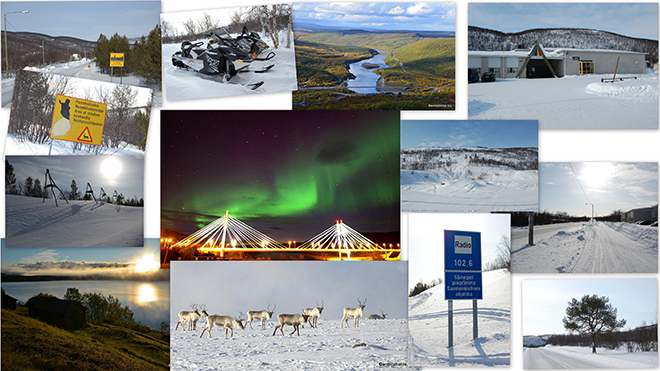Utsjoen saamelaislukio (Sami upper secondary school) - Finland
Region: Utsjoki
Other schools in the Quad Blog: Larkin Community College (Ireland), Zs Palachova (Czech Republic), Ernest Bevin College (UK)
Creative Connections Project: Mapping identity
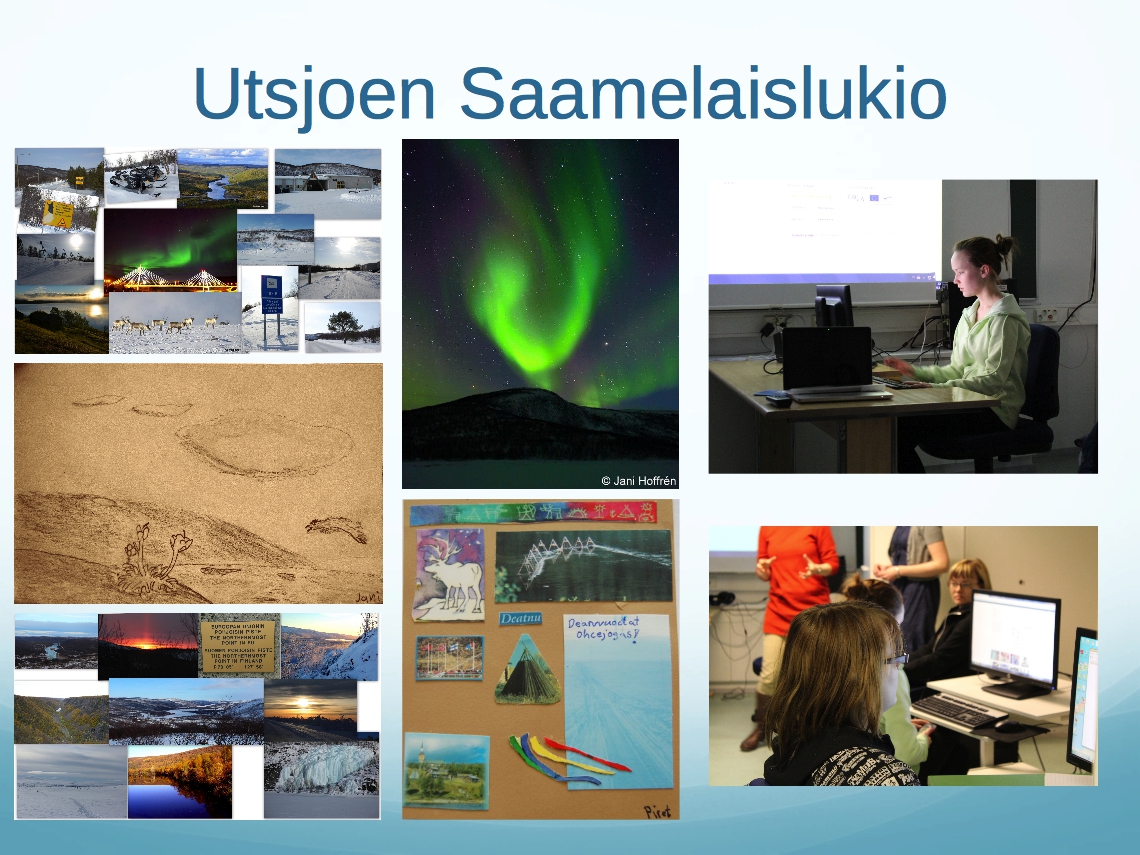
Utsjoen saamelaislukio, is the Sami upper secondary school of Utsjoki. Utsjoki is a rural upper secondary school. The students participating in the Creative Connections project were 11 students from the obligatory Art course: Image, space and environment. They were 1st and 2nd year students, 16-17 -year-olds, and worked with the project from 6th February to 8th April 2012.
Utsjoki is located in the Northern part of Finnish Lapland, on the shore of the river that marks the border with Norway. Utsjoki is a small community of 1280 inhabitants, who are a mixture of Finnish and Sámi speaking people, and this is the only community in Finland with a Sami speaking majority. Utsjoen saamelaislukio – Utsjoki Sami upper secondary school is theupper secondary school in the European Union. Besides the national curriculum courses which are followed the school also has courses which specialize in Arctic and Sami issues. There are 10-30 students in the schools and the school has free boarding for the students who live far away. The school is proud to be multicultural and welcomes students from the whole Sami area, around Finland and also from Northern Norway (which actually is 2km from the school across the bridge).
Student comment
Then we made the school presentation videos. There we tried to explain, because they don’t understand for example in Ireland, that in our school there is a primary school, secondary school, upper secondary school, a library and a swimming hall – all in the same building.
Special Issues
The Creative Connections project was included in a compulsory art course for the students. The course is called Environment, Place and Design. It is part of the national curriculum. Thus the work student created had to follow the course theme and curriculum. Blogging was then an extra and new thing, an exception to the normal content of the course. So in Utsjoki, compared to the secondary school in Oulu, the students were not volunteers on the course, but followed the curriculum and the obligatory course.
The course was timed in the first period (6 weeks) of the 2102, so the students had only a short period to blog in February and March. This caused the lack of comments and feedback, since the other schools in the Quad Blog started blogging later. After the visual arts course, the students continued the use of the blogs and Connected Gallery in the spring with the English teacher. They studied English by writing essays when they analysed the artworks.
Due to the extreme northly location of Utsjoki, the researchers could make only two visits to the school in comparison to the five or six visits to other Creative Connections schools in Finland. The teacher then had less support in using the website and the blogs and carrying out the project with the classes than the other schools.
Teacher comment
Luckily the students were so handy (with computers), or we wouldn't have been able to put there videos to the blog otherwise, if they haven't been so skilful.
Creative Connection Project
Aims and Framework: The course content had to fit to the aims of the national curriculum, which for this course was focusing on design, architecture, place experience and environmental planning. So the teacher had to combine identity, with assignments related to the students living environment.
- My Europe
- Introduction video of the school in small groups
- My Childhood places
- Postcard from my locality
- What makes my home place special – photo series
- Plan for Environmental Artwork
(image: My Europe –collage)
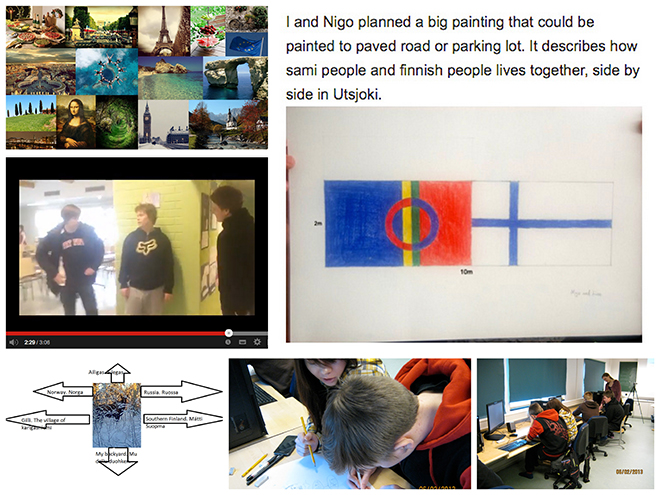
Teacher comment
Of course the project affected the course content and we didn't have time to do much more than these drawings. Normally on the architecture course, we’d have done something concrete (3D), for example the sculpture in the cafeteria, so now that was left undone. And on the last assignment, where they planned an environmental artwork for the village, we didn't have time for more than to do planning on paper. So we didn't have time to do something bigger. This took time.
The Use of the Connected Gallery
The course content followed the national theme about environment, place and objects. So the assignments concentrated on the students’ surroundings, places, memories and identity. The Connected Gallery was used only at the beginning of the project, when the students analysed some of the artworks. The art course ended, but the English teacher and literature teacher were interested in using the Connected Gallery images with the same students in practicing visual analysis and writing essays. At the end of the school year some of the texts and images were used in the school’s publication.
Teacher comment
It was really good that the other teachers continued with that. We even ended up getting some of the texts and image in the annual report.
The teacher used a printed version of the Connected Gallery (from a PDF version of the database that was given during the teacher training session) in the lesson, since they had problems in using the database online. The students could not access it at the beginning at all. The students chose interesting artworks that were then analysed more closely. Especially the painting Coffee Break by Markku Laakso which stimulated a discussion about the traditional Sami dress that the girl in the image is wearing.
Teacher comment
I would have needed more instructions and examples on how to use the artworks. Technically we had also problems to access it in the website.
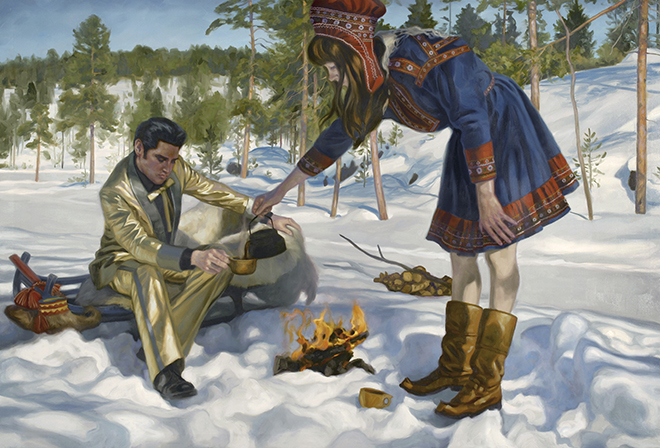
The students did not think the dress was correct and they pointed out the flaws in the costume that Laakso portrayed, but ended up in the notion that probably the other users of the database could not tell the difference. The teacher also wished that the descriptions for the artworks would have been shorter. She commented that even the upper secondary students were not motivated to read them. The language on the other hand was not a problem, since the translator provided the texts in Finnish.
Identity and European citizen themes
Teacher comment
At the start it was much about just who we are and how we want to present ourselves, our own identity. It feels like that kind of introducing who we are and where we are from took us a lot of time in the beginning.
Mapping identity was the main theme and approach to the contemporary art for the students in Utsjoki and also in using the Quad Blog. The most common theme for the students’ work on mapping identity was their own environment. In the city, young people’s depictions emphasise the built environment while the rural student concentrates on nature and the seasons. A second common topic in students’ work’ was their favourite things and youth culture related themes. The images varied from concrete to conceptual using different activities and things. There were also plenty of subjects which dealt with nationality and ethnicity in the Utsjoen saamelaislukio school blog. In this kind of work they related to their roots, language and ethnicity, touching on history, geography and traditions. The way the students represented nationality in their work was mainly realistic reporting or describing. The work was often created through photography or collages, and aimed to portray their target as clearly as possible.
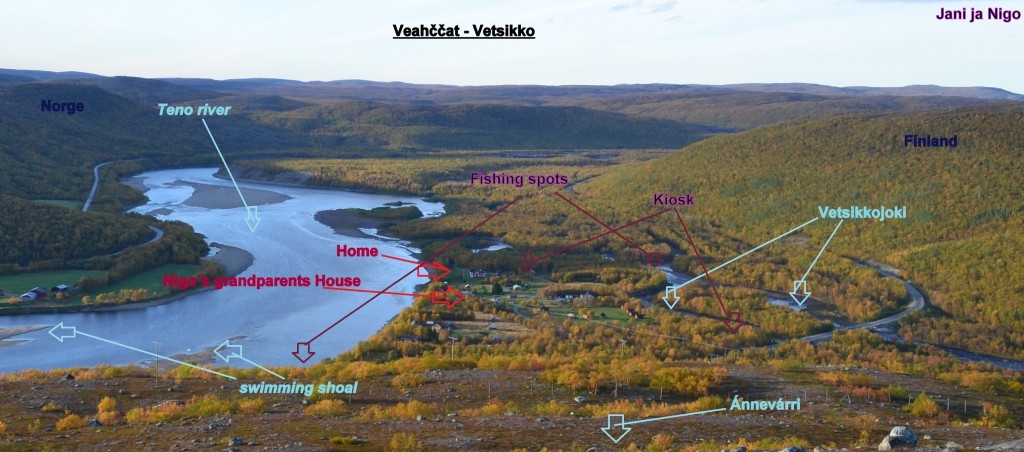
Student comment
Like in that photo from the top of the fell. That maybe for the Irish and the others, when they pictured their city streets and a bus or a metro with people bursting out. One student, Jani, photographed how the sun shines on the autumn colour leaves and you can see the fell and the river in the background. So that made me sort of notice, I don’t know if that was the whole idea, to compare the people’s living environments and how they reflect on people’s identities and other things. That at least was something I realised when comparing our works to others.
Blogging
The teenagers took well to the blogging task. Some of the upper secondary school students used the blog fluently and already had experience in blogging (with blogging of photo blogs). Still they found the blog system too complicated and not always functioning. They would have preferred more youthful blog with simpler navigation. It took several weeks for them to learn the blogging environment. A challenge was also the short introduction to the blog environment that the teacher got in the training day, and she had to know how to use the blog after that. Some help was given during the few researcher visits and by the skilful students. The blogging seemed take a lot of time from the course lessons.
Student comment Blogging made the course more like a media course, than a normal art course.
Student comment NOW, after the 5 weeks course, I know how to use the blog. But the course is over.
Teacher comment Blogging took time from making the artworks. Normally on this course they would have also made the environment artwork, now they made only plans.
The discussion in the blog was correct and on a general level. The comments were positive and encouraging. The students were not that interested in asking questions, only concerning a few works that were especially insightful or difficult to interpret. The positive feedback comments can be divided roughly in two: about the subject or technical skills. The feedback for skilful execution concentrated on creativity and attractiveness and there was often expressed an expectation to see more good works. The positive feedback for the subject of the work was given often for a posting where effort was put into the explanatory text which accompanied the image. Correspondingly the art work without explanation of the story or the process, despite how amazing they would look like, did not evoke any comments or only some questions. According to the students the challenge was that the assignments were not similar for all the groups and as a result it made interpreting other work in the blog more difficult. There was one exercise with the same theme of art as a statement/action from an Irish school and the students found it interesting to see the work of others, but the work needed clearer descriptions for them to understand what the work was for. Many of the students also felt that it was challenging to try and transmit to others the difference in their own life and environment.
Student comment
There could have been a presentation or info page in the start of the blog with some facts and information about the classes in the blog. Now it was quite unclear who the other bloggers were, and there was no easy link in place to check and get the information.
Teacher comment
I wished that we would have seen concrete faces, that of who we are co-operating with. Now it was so virtual. If the students would have been able to have a conversation, for example through a chat or even better in Skype with a camera, that would have been really good. It would have made it more concrete. Now it was like communicating with a computer.
The blogging also raised the question of privacy and security, when starting to post images and video where the students which show themselves. The issue was discussed and the students came to the result that the environment was safe, since it was only for the registered users and not for outsiders.
Generally the other blog postings were interesting and inspiring, but there was one exception.
Teacher comment
We looked at the other schools introductions and there was a school which had done a really elegant video. The students were totally depressed thinking that they have so much in there to do all really fancy things and we have only this one little video camera, that do we even dare to show our school? It was a total fiasco.
The fine images in the other presentation video almost took out all the motivation, but after starting to work with the video the students were excited in using that media and had a good time in doing their video presentations. The example shows that blogging does not bring only good and positive things in educational use.
Summary
The project was carried out under the framework of the compulsory art course Environment, Place and Space, which effected the assignments. For the students the course felt more like a media course, because of the time and effort put into the blogging. The students were self-guided and uploaded their works to the blog environment themselves and commented on other participants posts actively. Even though they were used to working on the internet, the students found the blog too laborious and complicated and it took them several weeks to learn how to use it.
The use of techniques like photography and drawing made it easy to post the results on the blog and since the making of the works was not a long process there was energy left for blogging. Due to the concentration on the environment on the course, technical issues and the teacher’s lack of information and support, the meaning of Connected Gallery was left vague for the students and it was not used much in relation to the assignments. Still the most missed part was the interaction between the other students on the blog, as the other schools started the posting later than Utsjoki school due to the Finnish pupils being forced to work on the project in the early spring because of the periodical system.
Student comment
Because I’m using a camera a lot, it was easy to put the pictures on the net. It would have been more laborious, if we would have done for example ceramics. So we would have been working on some pot for hours, and then you would have needed to photograph it and post the picture and write the text. But now it was more this kind of media course, that the assignments themselves were already...And there wasn’t so many artistic assignments to do.
Student comment We have accomplished a lot, 73 posted articles.
Teacher comment
There should have been more communication (interaction in the blog). But I’m still quite satisfied with the upper secondary group’s outcome.
Student comment
This work tells a lot about the Utsjoki landscape, but it has no comments. So we don’t know who has seen this post. At least I tried to comment on every work that I looked at in the blog, “Nice job”, if nothing else. Then they would know I have seen their post.
